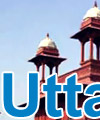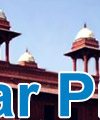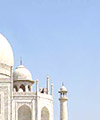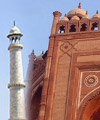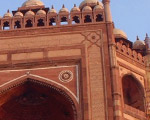|
Fairs & Festival
The people of Uttar Pradesh reflect their colorful vibrancy through
the fairs and festivals they celebrate. People from town or from
village enjoy the festivals all the year round with great fervour.
Fairs and festivals are celebrated with traditional gaiety, its
a celebration of life at its best in Uttar Pradesh.
Holi
Holi-the festival celebrating the beginning of spring, is one of
the most colourful festival celebrated with great enthusiasm all
over India. Holi signifies the triumph of good over evil and is
marked by grand festivities all over India and particularly in the
Braj area where it is celebrated with great gaiety and fervour.
It is believed that Lord Krishna, an incarnation of Lord Vishnu,
in human form played holi with the Gopi's in the ancient past. Keeping
this tradition alive in Braj, Holi celebrations last for more than
a week and are marked by people sprinkling colored water and smearing
colored powder on each other.
The playful teasing of the Gopis by the Gopas (cowherd boys) is
enacted by groups of men and women through special Holi songs and
dances, called Rasiya.
Barsana Holi
48 km. from Mathura at Barsana, is celebrated the famous "Latthmaar
Holi" of Braj. It is said that Krishna used to come from Nandgaon
to Barsana to play Holi with Radha along with his Gopi friends.
The Gopis after merriment chased away the Gopas of Nandgaon by beating
them with "lathis". So it came to be known as the 'Latthmar
Holi' of Barsana.
To this day, the village women have the freedom to literally take
up cudgels against their menfolk, a right they exercise with all
enthusiasm and shower colored water as an expression of joy. The
main celebrations at Barsana, takes place at the Ladliji temple,
dedicated to Sri Radha Rani.
Nandgaon
The day after Barsana Holi, it's the turn of Nandgaon to get soaked
with the innumerable colours of holi. The men and women of Barsana
go to Nandgaon (7 km.) to play Latthmar Holi with each other.
Dadjee Ka Huranga (Baldeo)
20 km. from Mathura, is a town named after Balram the elder brother
of Sri Krishna. A temple dedicated to Baldeo stands in the centre
of the town. The Holi festival celebrated here is famous as Daujee
Ka Huranga. Men and women gather in large numbers to play holi.
Falen
Falen is a village 15 km. from Kosi, celebrates Holi in a very special
way, which has great significance. A "Panda" (Holyman)
walks bare feet over holy pyres without getting burnt, symbolising
Prahlad's emergence from the burning pyre unharmed.
Uttarayani Mela
This fair is held at a number of places including Bageshwar, Rameshwar,
Sult Mahadev, Chitrasila (Ranibagh), Hanseshwar etc. on Uttarayani
Day. A very big fair is arranged here and various things like blankets,
durries, cane and bamboo articles are brought and sold.
Shravan Mela, Jageshwar, Almora
Jageshwar lying in the beautiful Jatganga valley, housing one of
the 12 Jyotirlingas of India, is a complex of 12 temples in all.
Two large fairs are held at Jageshwar, one at the occasion of Shivratri
and the other in the month of Shravan (July-Aug).
Doonagiri Mela, Almora
Situated at an elevation of 2116 mts. Above sea level, Gananath
is 47 kms. From Almora and is known for its natural landscape. A
fair is held here every year on Kartik Poornima (Oct./Nov.) when
thousands of pilgrims come to worship Lord Shiva and Ganesh.
Dwarahat Mela, AlmoraSituated in the wide valley of Ram Ganga (West),
Dwarahat is 38 kms. from Ranikhet having a cluster of old temples.
A huge fair is organized every year on Baisakhi day.
Kasar Devi Mela, Almora
The picturesque old part of the town is the venue for a fair held
twice a year during the summer and winter months. It is said that
Swami Vivekananda gained enlightenment in a small cave at Kasar
Devi in Almora.
Nanda Devi Mela
A fair of great religious and cultural significance is held at Nanda
Devi Temple in September to commemorate the memory of Goddesses
Nanda and Sunanda. It is said to have started in Kumaon during the
reign of Raja Kalyan Chand in the 16th century.
Nanda means prosperity and well being. Nanda Devi Mela is held
as a symbol of prosperity, both material and spiritual, of the hill
regions. The Nanda Devi Melas are held at Almora, Nainital, Nauti,
Dandidhara, Munsyari and Ranikhet, of which the Almora and Roopkund
fairs are the most famous.
Top
Almora
At Almora thousands of people take part in the procession carrying
the dola of Nanda Devi. The Nanda Devi temple of Almora built during
the reign of Raja Udhyot Chand, is the venue for the three day long
Nanda Devi fair.
Roopkund
Roopkund is the venue for a pilgrimage known as ‘Nanda Raj
Jaat’ of ‘Jatra’. It is held every twelve years.
This auspicious yatra takes place when a four horned sheep is born.
This sheep leads the yatra from Nauti village near karna prayag
and ends at Homkund beyond Roopkund, where the sheep disappears
in wilderness. This is said to be the spot where Shiva married Nanda.
Jauljibi and Thal Fairs
This fair is held every year on Makar Sankranti at Jauljibi, 68
kms. from Pithoragarh, at the meeting place of rivers Kali and Gori.
People come even from Nepal to this fair to sell horses, ghee, foreign
goods and take back foodgrains, jaggery etc. A similar fair is held
at Thal on Vaishakh Sankranti (14th April).
Syalde Bikhauti
Celebrated on the Vishuwat Sankranti day commemorating an ancient
victory. The festival is held at Syalde Pokhar in the old town of
Dwarahat. The occasion is marked by enchanting music, song and dance.
Devidhura Fair
Held on the day of Raksha Bandhan at the Varahi Devi Temple, Devidhura
is situated at the trijunction of Almora, Pithoragarh and Nainital
districts. A unique feature of the fair is the image of the goddess,
kept in a locked brass casket. This casket is taken in procession
to a nearby mountain spring where a blindfolded priest ritually
bathes the image and places it in the casket. The whole night the
goddess is worshipped and the next morning the exciting "Bagwaal"
fair is celebrated. Two groups of men duly purified, fight a "battle"
in front of the temple flinging stones at each other, while thousands
gather to watch.
The Somnath (Masi) Fair [Fish Festival]
This fair, also on Vishuwat Sankranti day is held in the Shiva temple
at Masi, Almora. It is a famous fair of Pali Pachhaun. Brisk business
takes place during the fairs and specially bullocks and calves are
sold. The fish festival is locally known as Dahau.
Punyagiri Mela, Pithoragarh
Punyagiri Shakti Peeth (20 km. From Tanakpur) situated on the top
of a mountain on the right bank of the river Kali is the site for
many fairs. The temple is very crowded during the months of Ashwin
and Chaitra for Navratri. The Punyagiri fair, starting from Vishuwat
Sankranti is the longest fair of Kumaon, lasting for about 40 days.
Sravan Jhula Mela, Ayodhya
This mela celebrates the playful spirit of the deities. On the third
day of the second half of Shravan, images of the deities (specially
of Rama, Lakshman and Sita) are placed in swings in the temples.
They are also taken to Maniparvat, where the idols are made to
swing from the branches of the trees. Later the deities are brought
back to temples. The Mela lasts till the end of the month of Shravan.
Shakambhari Devi Fair
95 km. from Haridwar and 45 km. from Saharanpur at the famous Shaktipeeth
of Shakambhari Devi, large fairs are held during both the Navratris.
Kartik Poornima and Lolark Shasthi Varanasi
Varanasi is the land of festivals. Kartik Poornima celebrated in
the month of Nov.-Dec., is the sacred day, when the ghats of Varanasi
come alive with thousands of brightly lit earthen lamps. Visitors
throng in large numbers to watch this spectacular event, famous
as Dev Deepawali.
Lolark Shasthi falling on the 6th day of the bright half of Bhadrapad
is another festive occasion of Varanasi. Thousands gather at Lolark
Kund, Bhadaini to bathe in its waters and worship the Sun God. Dala
Chhath, Rang Bhari Ekadasi, Burhwa Mangal and Annakut are among
the other important festive occasions for Varanasi.
Hatkalika Fair, Gangolihat
This fair is held on the astami of Chaitra months in the kalika
temple at Gangolihar. People come with drums and flags to pay homage
to goddess Kalika.
Tapkeshwar Fair, Dehradun
6 km. From Dehradun is the famous Tapkeshwar Shiva Temple. Annually
a fair is held here on Shivratri dedicated to Lord Shiva.
Surkhanda Devi Mela, Tehri Garhwal
This fair is held on the occasion of Ganga Dussehra at the Surkhanda
Devi Temple dedicated to Goddess Durga. Situated 20 km. From Mussourie,
the temple is an important pilgrimage centre and can be reached
by a 2 km. Trek from Kaddukhal via Dhanolti on the road to Chamba.
The worship of the Goddess is the main attraction of the fair. In
addition to folk music and dance, traditional handicrafts are also
on display.
Kunjapuri Mela, Narendranagar
This fair is held in mid October during the Navratri days. Over
fifty thousand people gather to participate in the activities. Handicrafts
and home made articles are put up for sale.
Lakhawar Fair, Dehradun
This village fair is held during Sept.-Oct. and is very popular
in the neighboring area of Chakrata, 78 km. From Mussourie. The
fair reflects the customs and traditions of the Garhwali tribes.
Mata Murti Ka Mela, Badrinath
On this day the mother of Shri Badrinathji is worshipped, and a
large fair is held at the Badrinath Temple in the month of September.
According to a legend, when river Ganga descended on earth to help
the suffering humanity, she spread into twelve channels. The spot
where the river tumbled became Lord Vishnu’s abode. The place
came to be known as Badrinath. The Mata Murti Temple is dedicated
to the mother of Sri Badrinathji.
Janmashthami
and Krishna Leela
Janmashtami, the birth of Lord Krishna is celebrated with great
devotion in the months of August/September, on the Ashtami of Krishna
Paksh or the 8th day of the dark fortnight in the month of Bhadon,
in the whole of north India.
Temples and homes are beautifully decorated and lit. An attractive
feature of the celebrations are cribs and other decorations depicting
stories of Lord Krishna's childhood. There are five main "jhankis"
of Janmashtami which depict the entire sequence of events from Lord
Krishna's birth to his being discovered in Gokul. "Jhankis"
are created out of dolls dressed up as kids, men and women with
lehangas, chunnis, dhotis and kurtas.
Raslila of every type are also performed - Janmalila, Shankarlila,
Putnalila and Naglila. In the evening bhajans are sung which end
at midnight, the auspicious moment when Lord Krishna was born. Thereafter
arti is done, prasad distributed and flowers showered on the idol.
Celebrations at Braj Bhoomi
Mathura, the birthplace of Lord Krishna, where his parents lived
in captivity of the evil Kansa and he as a young boy came and vanquished
his maternal uncle Kansa to ascend the throne and free his parents,
celebrates Janmashtami with great enthusiasm. The main celebrations
are performed at the Dwarkadhish temple, Mathura in the form of
Jhulanotsava and the Ghatas during the entire month of Shravan.
The ghatas are a unique feature of the month long celebrations.
During the ghata of a particular colour the whole temple is covered
with decoration in the same colour. Even the Lord dresses up in
the same colour. The twin cities of Mathura- Vrindavan deities are
brought back to temples. The Mela lasts till the end of the month
of Shravan.
Rath Ka Mela, Vrindavan
The Rangaji temple, Vrindavan, is also the venue for the annual
Rath Mela, celebrated in March-April. The chariot of Lord Rangaji
is taken out from the temple with great enthusiasm by thousands
of devotees.
Top
Nag Nathaiya Leela, Varanasi
The Tulsi Ghat at Varanasi is a venue for the 20 day long Krishna
Leela celebration, of which Nag- Nathaiya Leela, one of the episodes
is extremely famous. Lord Krishna enacted by an artist, jumps into
the river as the play reaches climax and emerges on the serpent
hood of Shesh Nag. Lakhs of people gather on the ghats of Ganga
to witness this special enactment.
Jhanda Fair, Dehradun
This fair marks the arrival of Guru Ram Rai, the Sikh Guru, at Dehradun.
In the year 1699, Guru Ram Rai built a Gurudwara, Guru Ram Rai Durbar
and hoisted the flag. Till this day a large fair is held here every
year in the month of March/April on the sixth day after Holi and
a flag (Jhanda) unfurled at the Jhanda chowk.
Hanol mela, Chakrata
The temple of Hanol at Chakrata, 78 km. from Mussourie is the venue
of an exotic fair. The hill dwellers of the state gather in October
to worship in all their finery. This is an opportunity to exchange
messages, purchase house wares from various merchants and to celebrate
with friends and relatives before the onset of a harsh winter.
Neelkanth Mahadev Mela, Rishikesh
Situated at a height of 1675 mts. on a hill above Swarg Ashram,
Neelkanth Mahadev is one of the most revered temples of Rishikesh.
According to a legend, after the great ‘Sagar Manthan’
the churning of the sea by gods and demons, Lord Shiv drank all
the effluent venom that turned up from the manthan. The poison turned
his throat blue and hence the name Neelkanth (Blue throat). An important
fair is held in the Hindu month of Bhadrapad (July/August) in the
temple.
Kavand Mela
Ten days before Shivratras (during the months of Shravan and Phagun)
thousands of devotees throng to Haridwar to collect holy waters
of the river Ganga. Then they carry it back to their hometown and
offer it at the local Shiv temple. Colorful shops spring up and
Haridwar resounds to the chanting of hymns.
Ramlila
Ramlila, the enactment of the story of Lord Rama is believed to
have been started by great Saint Tulsidas. The Ramcharitmanas, written
by him till today forms the basis of Ramlila performances. In some
places, Ramlila is associated with the Vijayadashmi celebrations
in late September and early October and also with Ramnavami, the
birthday of Lord Rama.
Ramlila, basically an enactment of a myth, is presented as a. cycle-play
with the story varying from 7 to 31 days. The Ramlila performance
evokes a festive atmosphere and enables observance of religious
rites. It is also rich in performing arts such as costume jewellery,
masks, headgear, make-up and decoration.
Chitrakoot Ramlila
Celebrated for five days every year in the last week of February
at Chitrakoot beginning from the Maha Shivratri day.
Varanasi Ramlila
The Ramlila Festival (October- November), is celebrated with great
fervor at Varanasi. Jhankis and pageants depicting scenes from the
life of Lord Rama. Some of the episodes of the Varanasi Ramlila
are witnessed with great interest.
Ramnagar Ramlila
Ramnagar, 15 km. from Varanasi presents the Ramlila started by the
erstwhile Maharaja of Kashi in the most traditional style. The performances
lasting for 31 days are marked by detailed dialogues and impressive
enactments. Hundreds of sadhus called Ramayanis come to Ramnagar
to watch and recite the epic. Permanent structures are built and
spaces designated to represent the main locales of the story i.e.
Ashok Vatika, Janakpuri, Panchvati, Lanka etc. transforming the
whole township into a vast Ramlila ground. The audience move along
with the performers with every episode to the next locale. To maintain
the austere character of the Ramlila, electric lights, mikes and
loudspeakers are not used, though the average audience is rarely
less than ten thousand.
Allahabad
Dussehra
Allahabad Dussehra is marked with the unique procession of beautifully
decorated "chowkis" accompanied by Ramdals every evening,
that are taken out from different Localities, from four days preceding
Dussehra.
Ayodhya
The place is popular for mandali Ramlilas. The performance is dialogue
- based and presented on a platform stage. High standard of performance
is complemented by songs and kathak dances and eye- catching decor.
Kumaoni Ramlila, Almora
The festival of Dussehra is celebrated with great pomp and show
all over Kumaon. Various Ramlilas are enacted depicting the story
of Lord Rama's victory over the demon King Ravana. The Almora Dussehra
procession is unique with huge effigies of gods, heroes and demons
paraded through the streets.
Ramnavmi Mela, Ayodhya
Ayodhya, the holy city of the sacred pilgrim centre of Hindus plays
host to the Ramnavmi Festival in the month of April. Thousands of
worshippers gather to venerate the Lord at Kanak Bhawan.
Devi Patan Mela, Tulsipur
Held in Tulsipur (Balrampur, Gonda) during Chaitra Navratri, this
fair is dedicated to Maa Patan Devi. Pilgrims come in large numbers
including several from Nepal. The festivities include cultural programmes
and religious ceremonies.
Kumbh
Mela
The month long Kumbh Mela of Allahabad is one of the largest fairs
of the world and is attended by millions of pilgrims from all over
India as well as the devoties from the world over. Maha Kumbh is
held after a gap of twelve years where as Ardha Kumbh is held in
the Sixth year after Maha Kumbh, in the months of January-February,
on the banks of the holy confluence (Sangam) of rivers Ganga, Yamuna
and Saraswati.
Kumbh Mela's originated at the time of the beginning of the Creation.
All devtas were under the influence of a curse that made them weak
and coward, Brahma, (the creator God) advised them to churn the
ocean for Amrit (Nectar). Devtas sough the help of demons for the
purpose. By their joint efforts, after churning Amrit was one of
the resultants, found in the last. Devtas fled with pitcher of Amrit
and demons chased them. A battle ensured. During this, the pitcher
of Amrit was kept at four places and few drops of amrit also fell
at these places. The places were Prayag (Allahabad), Hardwar, Nasik
and Ujjain. Since then Kumbh Mela is held at Prayag. The main Kumbh
parva is the day of Mauni Amavasya. Other important bathing days
are Makar Sankranti, Paush Poornima, Basant Panchami, Maghi Poornima
and Maha Shivratri.
The Kumbh Mela is generally held every three years in rotation
at Allahabad, Hardwar, Ujjain and Nasik. The period of Kumbh Mela
is Magh (Jan-Feb) month of Hindu calendar.
Ardh Kumbh
Held in the 6th year after Kumbh Mela, i.e. it falls between two
Kumbh Melas. It has got the same religious value and attracts millions
of people.
Magh Mela- The Annual Mini Kumbh
Except the years of Kumbh Mela and Ardh Kumbh Mela, Magh Mela is
held every year on the banks of Sangam. Magh Mela is held in the
month of Magh (Jan-Feb); hence it is called Magh Mela.
Kampil Fair, Kampil
Kampilya called Kampil today, is a village in tehsil Kasganj of
Etah district, situated on the banks of the Ganga. During the epic
period it was the capital of King Drupad, the father of the Queen
Draupadi. It was the birth place of the 13th tirthaiikar Brahlan
Vimal Nath and was graced by the visit of Lord Mahavir. Every year
a Jain Mela is held for five days in the month of March.
Bateshwar Fair, Agra
Situated at a distance of 70 km. from Agra on the banks of river
Yamuna, Bateshwar is an important spiritual and cultural centre.
The place is named after the presiding deity of the region, Bateshwar
Mahadeo and has 108 temples dedicated to the gods and goddesses
of the Hindu pantheon. During the months of October and November,
a large fair is organized from Shashthi of Kartik month to Panchami
of Agrahayan month. Devotees congregate here in large numbers to
worship Lord Shiva and take holy dips in river Yamuna.
Deva Mela, Barabanki
The annual urs of Haji Waris Ali Shah is celebrated during October-November
at Deva 10 km. from Barabanki. This fair attracts pilgrims from
as far as Pakistan and the middle east countries. The shrine of
the Sufi Saint is much revered by Muslim pilgrims all over the world.
Kailash Fair, Agra
Held at Kailash, 12 km. from Agra during the months of August-September.
It is a major fair celebrated in honor of Lord Shiva who is believed
to have appeared here in the form of a stone lingam.
Rambarat, Agra
The marriage procession of Sri Ram, is held every year during Ramlila
celebrations at Agra.
Every year a new locale of the town is chosen as Janakpuri, which
is elaborately decorated to perform the royal wedding. The Rambarat
(marriage procession) starts from Lala Channomaiji Id Baradari for
Janakpuri passing through different parts of the town.
Top
Info on Fairs and Festivals of Uttar Pradesh - India
|
